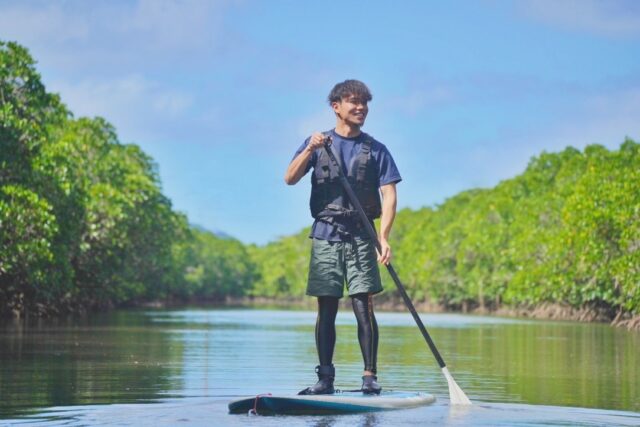Local Column
COLUMN
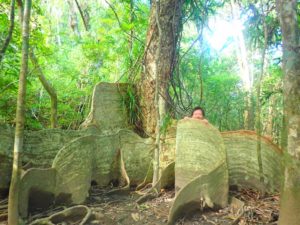
20 plants you can find in Ishigaki Island and surrounding islands! Ishigaki Island resident staff will give you a thorough explanation!
Hello everyone!
Ishigaki Island and its surrounding islands have a subtropical climate, which is rare in Japan. Because of this climate, there are creatures that are unique to that climate. The same can be said for plants.
For example, when we say mango or pineapple, we think of tropical fruits, right? Yes, they are.
Plants that are suited to the climate grow there. Ishigaki Island and the surrounding islands, which have particularly high biodiversity, are home to a variety of unusual plants.
In this article, we will introduce the plants that can be found on Ishigaki Island and its surroundings.
目次
Characteristics and reasons for the plants on Ishigaki Island
As mentioned at the beginning of this article, the Yaeyama Islands, located at the southernmost tip of the South, belong to a subtropical climate. Therefore, various subtropical plants that can only be found on Ishigaki Island and its surrounding remote islands, Iriomote and Taketomi Islands, grow wild. The color, size, and visual impact of these plants are all unimaginable on the mainland.
There are so many beautiful and attractive flowers that you can enjoy just strolling around and looking at the plants.
20 Plants of Ishigaki Island
Plants of Ishigaki Island (1) Gekko
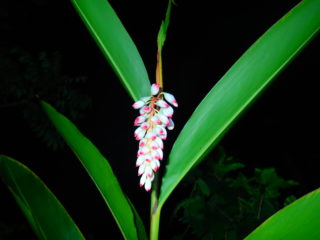
The first plant I would like to introduce is the "shell ginger.
Moon is also a member of the ginger family, Gingeraceae, and because it is a member of the ginger family, it grows toward the ground from a stem that burrows into the ground like ginger.
It is called "false stem" because the above-ground growth looks like a stem, but it is not a true stem.
This false stem grows up to about 2 meters and is very sturdy due to its fibrous nature. <
The yellowish-red flowers bloom from April to June, giving off a distinctive sweet fragrance, and the red berries appear from September to October, the seeds of which are used as the main ingredient in nintan.
Plants of Ishigaki Island (2) Modama tree
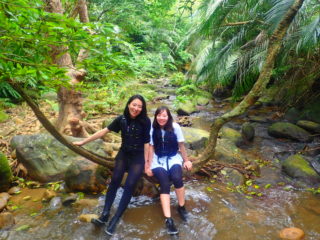
The next plant to be introduced is the "modama tree.
It is one of the plants you should definitely appreciate when you visit Ishigaki Island or Iriomote Island.
The modama tree is a plant that produces huge beans and is the famous tree that appears in "Jack and the Beanstalk". The ivy of this tree is very strong, and near Koola Falls in Iriomote Island, there is a strong ivy tree that can hold up to 10 people. This ivy is called "nature's swing" and is also famous as a photo spot, so please visit there when you come to Iriomote Island.
However, from the standpoint of nature conservation and accident prevention, do not overdo it.
Plants of Ishigaki Island (3) Ohirugi
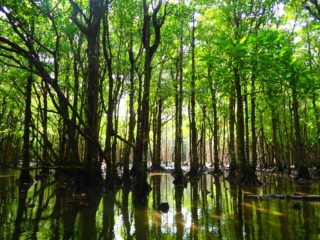
The Ojirugi is a tall evergreen tree that grows in mangrove swamps and can grow up to about 10 meters in height. Although it is a member of the mangrove family, it often grows closer inland in mangrove communities. As a result, areas inland from the mouth of the river are often dominated by the mangrove. The leaves are alternate, and are pollinated by visiting white-eyes, wasps, and bumblebees.
The roots are shallow in the ground, and the bent roots that emerge for ground walking are the respiratory roots. It was used as a building material because of its resistance to water.
Plants of Ishigaki Island (4) Mehirugi
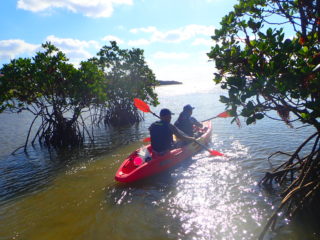
Like the Japanese hollyhock, the mehirugi is a member of the hirugiaceae family. The leaves are opposite and the yellowish-white flowers bloom from May to June. It has well-developed prop roots and aerial roots, and its seeds germinate on the tree before falling, making it tolerant of seawater.
Plants of Ishigaki Island (5) Yaeyama Hirugi
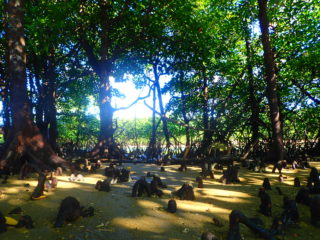
The next plant we will introduce is Yaeyama hirugi.
Yaeyama hirugi is the most visible mangrove species in the Yaeyama Islands. It has long, oval, thick, opposite leaves and red or pale yellow flowers that bloom from May to June.
There are huge native colonies on Ishigaki Island and Kohama Island, and on Ishigaki Island, colonies can be observed first in estuaries and inland enclosed water bodies.
Plants of Ishigaki Island (6) Deigo
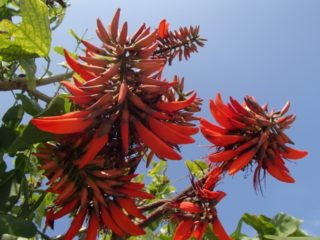
The deigo is a deciduous tree of the Fabaceae family and the Okinawa prefectural flower, and it is a plant that is very close to the Okinawans, as it appears in the lyrics of the island song by THEBOOM.
The bright red flowers bloom from early spring to early summer, heralding the arrival of summer to the locals. They are extremely beautiful flowers, but as it is said that typhoons visit when the deigo is in full bloom, the best time to see them is before the summer season, when typhoons are frequent.
Blooming in primary red, deigo is a flower that reminds us of the original landscape typical of Okinawa. The rows of deigo trees on Taketomi Island will be the best place to appreciate deigo flowers. Please visit there.
Plants of Ishigaki Island (7) Nipa palm
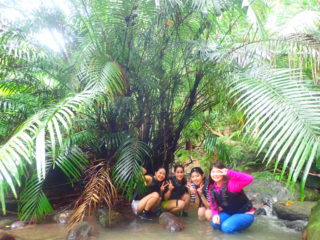
The nipa palm is a small evergreen tree that reaches a height of around 9 meters, belonging to the palm family. Although it is a medium-meter palm, it is also a mangrove plant that grows in the intertidal zone of the tropics and subtropics. It grows underground with bifurcated rhizomes and linear lanceolate, all-emarginate leaves.
In Japan, it grows only on Iriomote Island and Uchikiri Island.
Plants of Ishigaki Island (8) Kanbisakura
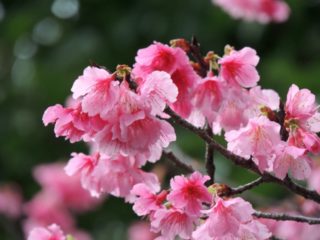
You can see the cherry blossoms one step earlier!
Okinawa is the earliest place in Japan where cherry blossoms bloom. The type of cherry tree is called kanbisakura. These cherry trees are characterized by their deep pink color. The name "Kanbisakura" is written in Chinese characters as "Kanbisakura" (meaning "cold scarlet cherry blossom"). As the name suggests, it is in full bloom in January and February, when winter is in full swing.
The Kaambi cherry blossoms, which bloom with their faces downcast, are different from the cherry blossoms on the mainland.
Cherry blossom festivals are held in various places on the island during the blooming season. Why not enjoy the earliest cherry blossom viewing in Japan while sipping Okinawa's awamori?
Plants of Ishigaki Island (9) Fruits of Adan
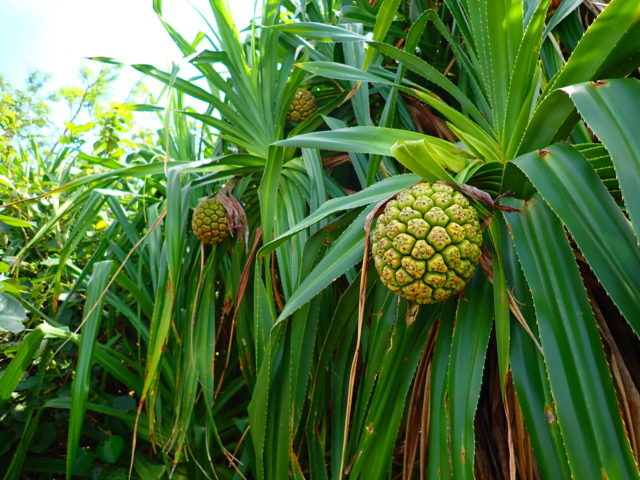
Adan is a plant that grows near the coast in tropical and subtropical regions. It is a tropical fruit with a distinctive pineapple-like visual. Many places on Ishigaki Island and Miyako Island entertain tourists with dishes using adan leaves and shoots.
Adan berries, as pineapple-like as they look, give off a pineapple-like sweet and sour aroma. However, as mentioned above, the leaves and shoots of adang are mainly used for cooking.
The first reason for this is that the berries are very hard. Adan berries are 4 to 6 cm in diameter, and are tightly packed together. The skin is so hard that it is difficult to pull the fruit out. They also need to be drained, otherwise you will feel a tingling and numb sensation in your mouth. Because of the above-mentioned cooking processes and complications, they are not often used in cooking.
Plants of Ishigaki Island (10) Yaeyama Palm Colony in Yonehara
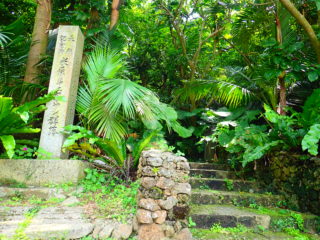
Yaeyama palms are designated as a national natural treasure, and the largest group of these palms in the world grow in a place called Yonehara on Ishigaki Island. This area is very naturally beautiful, and some of the trees in this cluster are as large as 15 to 20 meters.
In this cluster, visitors can observe not only Yaeyama palms, but also a variety of subtropical plants, such as the Japanese knotweed, the golden oaks, the redwood, the habu kazura, the kuwazui, the Japanese knotweed, and the Japanese knotweed.
Plants of Ishigaki Island (11) Fuki-tsuki-gawa Mangrove
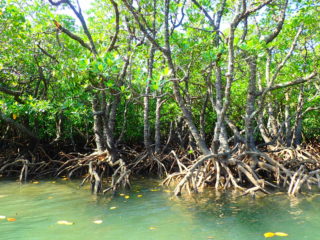
The Fukidori River is a river in Ishigaki Island surrounded by hirugi colonies, which are designated as a national natural treasure.
The mouth of the river belongs to a brackish area where seawater and freshwater mix, and as you go upstream from there, the types of native mangroves change due to fluctuations in salinity, making it very enjoyable to watch.
You can see the changes in the trees, such as the "Yaeyama Hirugi" with its roots shaped like octopus feet and the "Ohirugi" with its roots clustered together. There are also tours that take you upstream by SUP or canoe, so please check it out.
Plants of Ishigaki Island⑫Saxifraga japonica
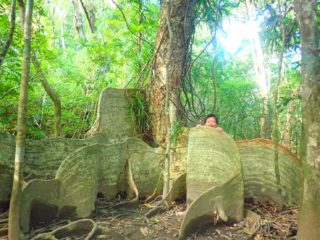
Saxifragaceae is a tall evergreen tree of the blue-green family that grows in wetland forests near mangroves.
The roots crawl on the ground in an unusual way, which is impressive and gives an impact to those who see it for the first time, as well as an exciting sensation as if they are lost in a mysterious world. We encourage you to explore the jungle!
Ishigaki Island Plants⑬Sagaribana
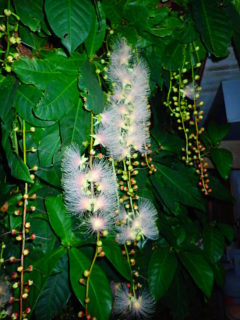
Sagaribana is called "overnight flower," and as the name implies, it is a fragile flower that blooms overnight and fades away overnight.
At sunset, the buds gradually begin to open. At sunset, the buds gradually begin to open, and at dawn, the petals fall off one by one. Since they grow in wetlands, they can be viewed while cruising along the river in a canoe or SUP. The sagaribana in full bloom in the middle of the night gives you the feeling that they are giving their all at this moment, which is very invigorating.
In the morning, you can see the falling sagaribana. The flowers have finished falling.flower petals fallen on water, resembling a spider flower (esp. Pelecanoides urinatrix)Although the season is limited from June to August, it is worth visiting during this season to see this spot.
Plants of Ishigaki Island⑭Bougainvillea
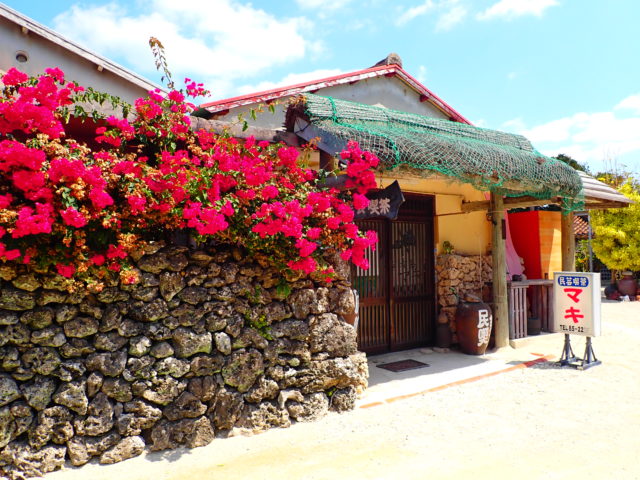
Bougainvillea is another flower with striking tropical colors. The flower color is a prominent shade of pink, red, or yellow, but has little or no scent.
The language of flowers of the bougainvillea is very uplifting, with words such as "passion" and "I see only you. Perhaps because of this, the bougainvillea is often named as a flower that women would be happy to receive.
If you have someone in mind, you may want to give this flower as a gift.
Plants of Ishigaki Island (15) Hibiscus
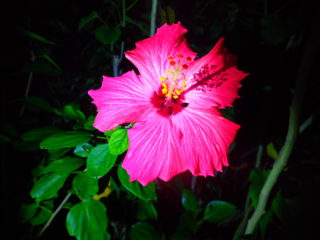
What flowers come to mind when you think of Okinawa and the tropics?
Hibiscus may come to mind for many.
The hibiscus, a representative of tropical flowers, is an attractive tropical flowering plant with vivid primary colors such as red, yellow, white, peach, and orange.
It has an image of red, but it comes in a variety of colors. Also, because they grow in the subtropics, they generally have an image of being heat tolerant, but in fact, it is known that species other than the coral type have fewer flowers when temperatures exceed 30 degrees Celsius.
It blooms in the middle of the summer season from May to October. You may want to visit during this season.
Ishigaki Island Plants⑯ Banyan Tree
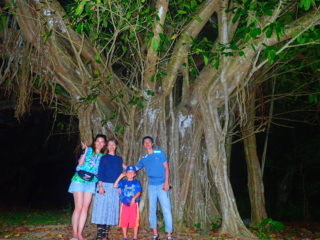
Banyan trees are often planted for wind and tide protection because they are large trees and can be transplanted.
The leaves are glossy and thick, and some of the young leaves are a bright yellow-green color, a garden variety called golden banyan. The origin of the unusual name "banyan" is unknown, but it is a very accessible plant that is also used for bonsai.
Plants of Ishigaki Island⑰Kuzuimo

Kwazuiimo is a member of the taro family. It is a very large plant with thick, rod-like storage stalks that crawl on the ground, with a stalk over 1 m long and leaves over 60 cm long at the top of the storage stalks.
As the name of the taro implies, the storage stem is poisonous and inedible. It is very similar to taro, so care must be taken not to eat it by mistake.
Ishigaki Island Plants⑱ Sugarcane
Okinawa is a major sugarcane production area. Sugarcane is called "uji" in the Okinawan dialect. This is probably the reason why the lyrics of songs by Okinawan singers often mention ouji.
How nice to write a song about your hometown.
Sugarcane is produced so abundantly that it accounts for half of the fields in Okinawa Prefecture. Sugarcane is also used as a raw material for brown sugar, and has become an integral part of our daily lives.
Sugarcane, the most productive agricultural crop, is used not only for refining sugarcane, but also for squeezed lees and sugar cane honey, making it an ECO plant that has almost nothing to throw away.
Plants of Ishigaki Island (19): Island bananas
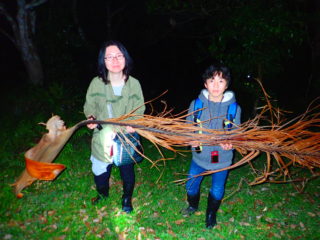
Tropical fruits are very popular on Ishigaki Island. Typical examples are pineapples and mangoes, but these are harvested only in June and July, so you cannot eat them even if you visit other than those months.
In such a situation, island bananas are the fruit that can be harvested year-round.
Island bananas are small bananas similar to the so-called monkey bananas. In Ishigaki Island, they are sold at unattended sales stands and can be easily purchased.
Such island bananas are characterized by their sticky texture and rich flavor. They are disappointing in terms of both texture and sweetness when not fully ripe, so it is necessary to carefully check when they are fully ripe.
The criterion for ripeness is when the stars are firmly connected.
Plants in Ishigaki Island⑳パパイヤ
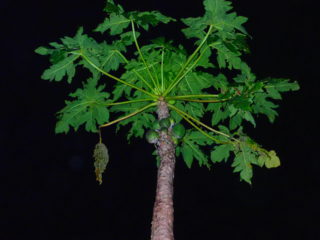
The last plant I would like to introduce is the papaya. Many of you have probably heard of it.
Papaya is a small evergreen tree native to Mexico, Costa Rica, and other areas around the West Indies. The fruit is football-shaped, 10 to 20 cm long, and turns from green to yellow as it ripens.
Papaya fruit is considered a complete food because it is extremely nutritious and low in calories. They contain much higher amounts of vitamins A, B, and C than other fruits, and are one of the most recommended fruits for women who are concerned about their skin.
The juice from papaya fruit was also used as a folk remedy by applying papaya fruit to wounds, as the juice has a mild bactericidal effect in addition to helping digest food, called papain enzymes.
At the end.
We introduced the plants of Ishigaki Island and its surrounding islands. How was it?
There were various plants such as hibiscus and dayigo, which stand out for their primary colors typical of Okinawa, sagaribana, which blooms all night long, and island bananas and papayas, tropical fruits of the tropics. Were there any plants that caught your attention?
Please look for it when you visit Ishigaki and the surrounding islands.
Thank you for reading to the end.

